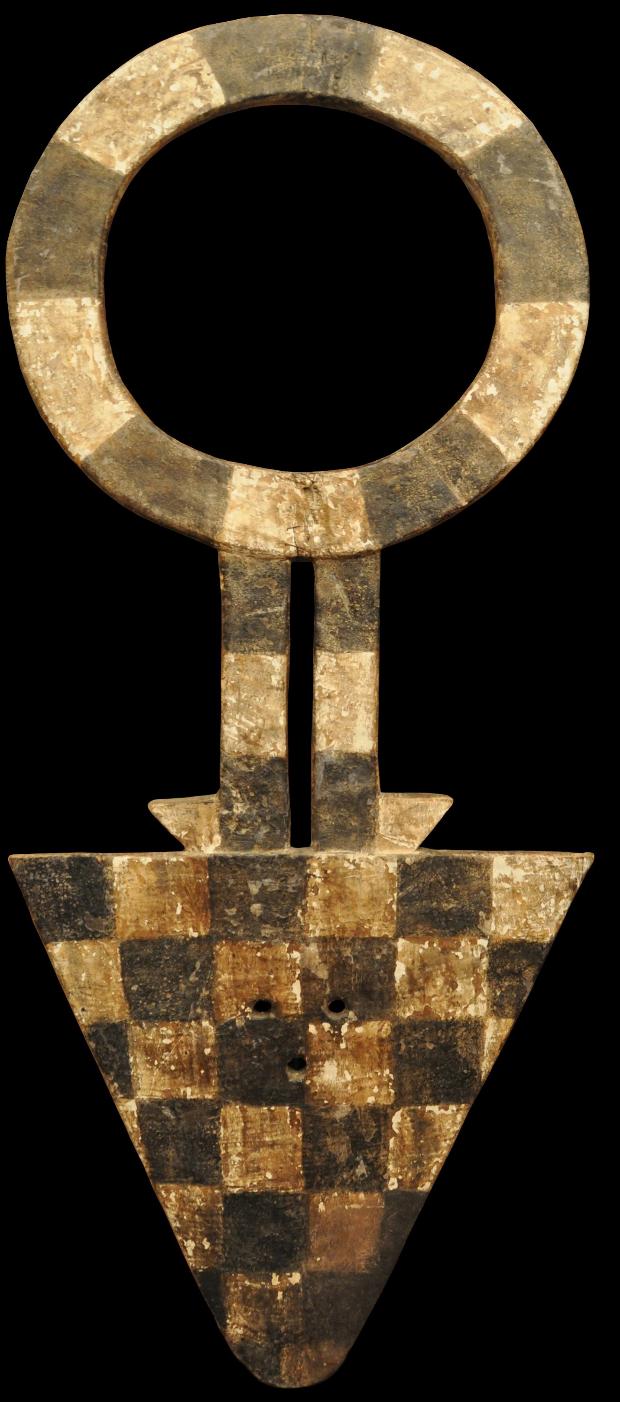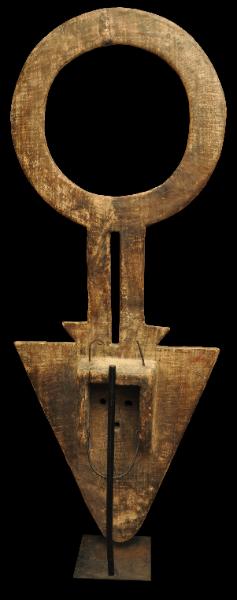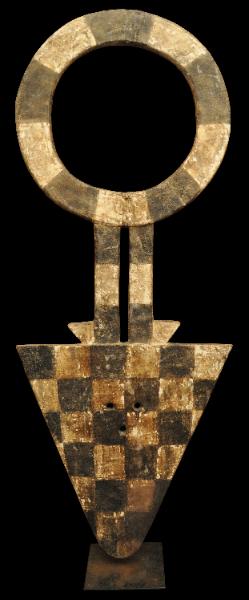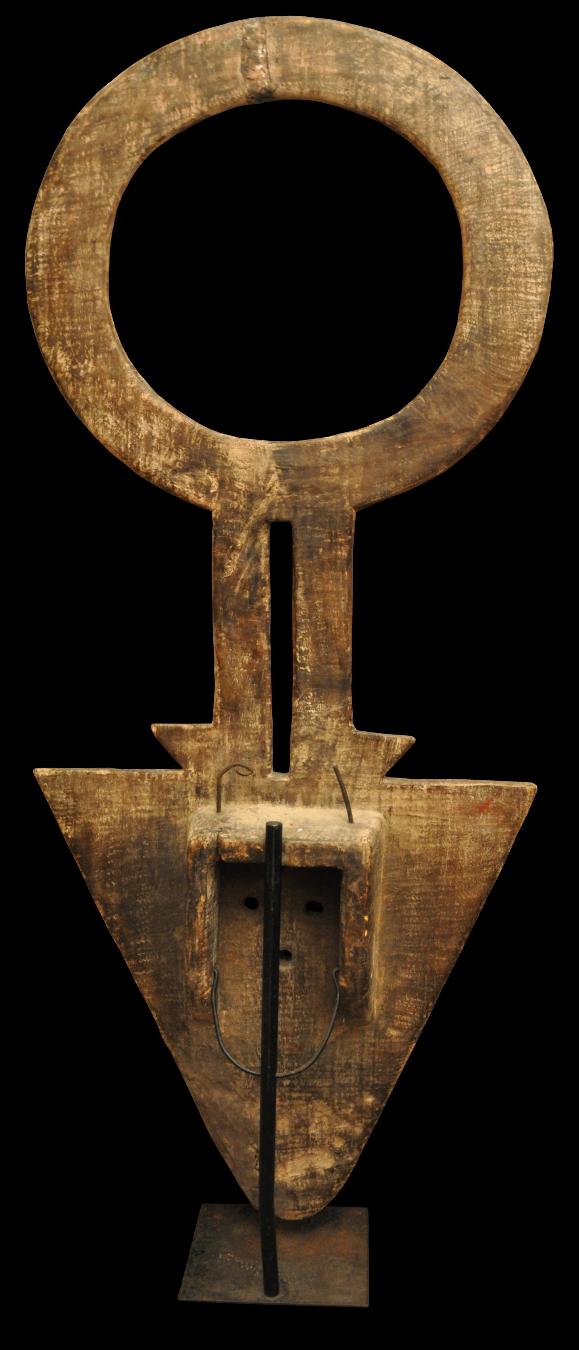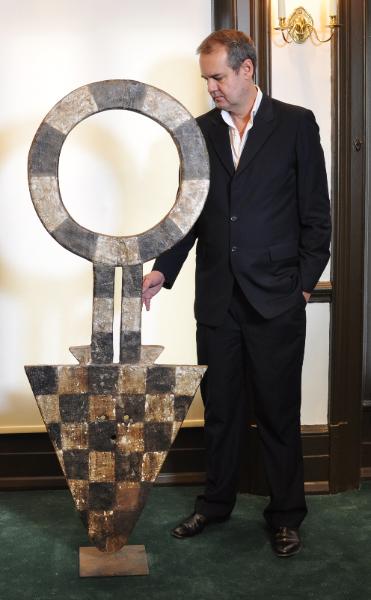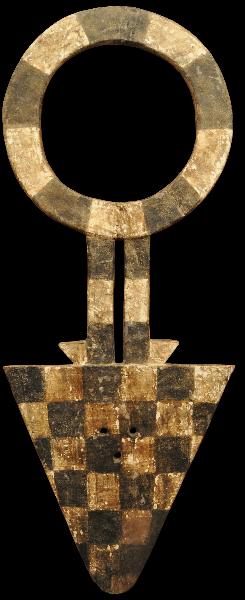
Bedu Nafana Plank Mask
Bedu Plank Mask
Nafana people, Ghana & Côte d’Ivoire
early 20th century
height: 168cm, width: 65cm
This wooden plank mask is large and geometrical in form. It was worn over the face with its extremities towering way above the head. The lower part of the mask is spade-shaped and pierced at the centre with three holes to allow the wearer to see out and with a third hole for the mouth. Its crest is surmounted by a large circular structure. The surface is painted in a checkerboard and zigzag pattern of black and white pigments. This group of masks are known as Bedu by the Nafana people who make and use them.
The edges are aged from wear and have a glossy patina. There is an old native mend to the base of the disk and the mend itself has wear and patina. The mask has ample wear from washing and repainting – features which were part of their regular ritual use.
Such plank masks are among the largest masks in Africa. The form of the Bedu mask represents a mythical buffalo-like animal that plays an important role in the New Year’s celebration in the Bondoukou regions of north-west of Ghana and the north-east of Côte d’Ivoire. Bedu masquerade is the focus of the month-long New Year’s celebrations, the winter solstice festival called Zaurau, where a pair of dancers perform with masks, one male and the other female. The gender of a mask is readily identified: male masks often have horns while female masks incorporate a large disk. Following this, then it can be seen that the mask here represents a female animal.
Smaller
Bedu masks with horns also seem to have been used for Zorogo dances, in which women mock their male counterparts by addressing the mask as their lover. Women prepared the masks by repairing, washing and repainting with the approach of Zaurau – the harvest season which also was a period of revelry and social laxity. Bedu masks and their performances represent and reinforce good social values: community harmony, health, fertility and good crops.
Bedu masks appeared in the early twentieth century – they are first recorded in the 1930s. They were similar in form to the Sakrobundi masks of the nineteenth century, which had been linked to an anti-witchcraft cult. Like the Sakrobundi masks, the Bedu masks belonged to one of the many secret societies, for which membership typically required initiation. During the initiation, young boys had to endure physical tests and an apprenticeship in secret knowledge of the supernatural. Sakrobundi and the secret societies were banned by the colonial government because they were seen as a threat to their authority.
A Bedu mask was offered at Christie’s London in their ‘Important Tribal Art’ sale, of November 30, 1994, as Lot 92. A later example is in the Jose de Guimaraes Collection and illustrated in
Africa: Jose de Guimaraes Tribal Art Collection (2009, p. 440). Sotheby’s New York also offered a plank mask in 2011. Click
here
to see that example.
The Nafana are a Senufo people living in the north-west of Ghana and the north-east of Côte d’Ivoire, in the area east of Bonduku. They number about 45,000and they speak the Nafaanra dialect within the Senufo language group.
Overall, this mask has exceptional sculptural value. Its large size, obvious age and naive colour scheme make it ideal for display in a contemporary setting as well as part of a tribal art collection. It has a custom-made stand which allows it to stand freely on the floor.
Provenance
UK art market
References
Africa: Jose de Guimaraes Tribal Art Collection/Coleccao de Arte Tribal de Jose de Guimaraes, Camara Municipal Lisboa, 2009.
Bacquart, J. B.,
The Tribal Arts of Africa, Thames & Hudson, 1998.
Dyke, C. V.,
African Art from The Menil Collection, Yale University Press, 2008.
Kreamer, C. M.,
African Vision: The Walt Disney – Tishman African Art Collection, National Museum of African Art, Prestel, 2007.
Phillips, T. (ed.),
Africa; The Art of a Continent, Prestel, 2004.
Inventory no.: 1172
SOLD

